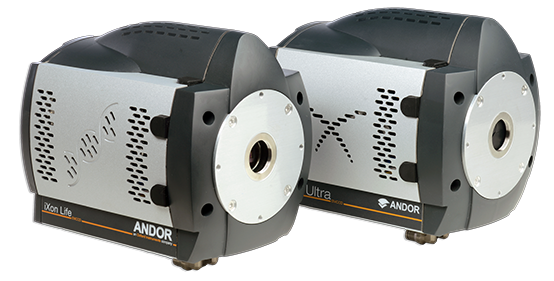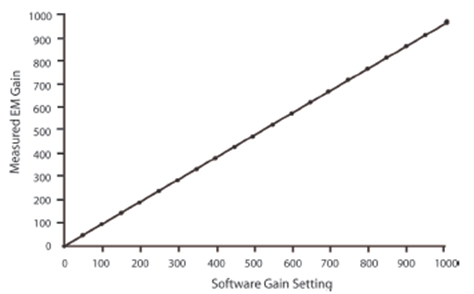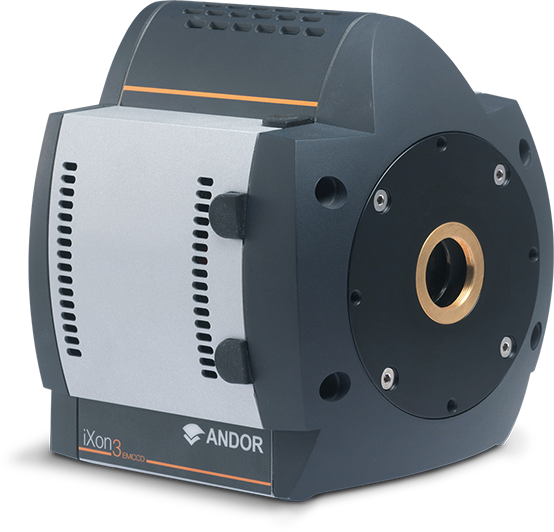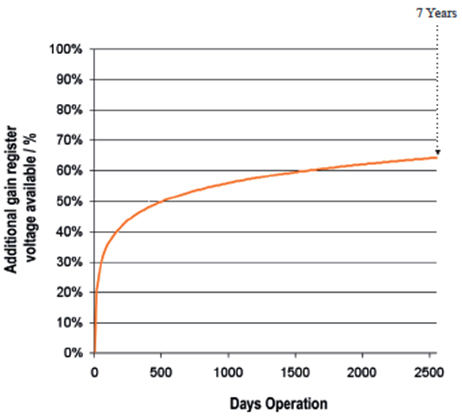Resources
 Part of the Oxford Instruments Group
Part of the Oxford Instruments Group
Expand
Collapse
 Part of the Oxford Instruments Group
Part of the Oxford Instruments Group
When EMCCD cameras were first introduced they enabled a level of detector performance with a level of raw sensitivity that remains unsurpassed to today. As with any new technology there were many questions about this new sensor technology, specifically around the unique feature of “EM gain” and technical challenges on how to best implement it in camera designs. In this article we look at the features introduced for the iXon EMCCD camera series that have addressed these challenges and helped iXon EMCCD cameras become the gold standard in EMCCD.

Figure 1: The iXon Life and Ultra EMCCD cameras are the latest EMCCD imaging cameras offering the best performance from EMCCD. These models follow many years of development and refinement of the technology in previous models.
For a general introduction to what is EMCCD and EM gain and how they work please see the article: What is an Electron Multiplying CCD (EMCCD) Camera.
For early EMCCD cameras the EM Gain that was selected in the software did not have a linear relationship with the real gain applied by the camera. While this has long been resolved, and the solution appears quite logical, initially at least this non-linear response made it more difficult for users to make the kind of quantitative measurements that these cameras were finding use in.
The solution that addressed EM Gain linearity and implemented in the iXon camera series, was called RealGain™. By performing detailed analysis of the EM voltage dependence, it was possible to convert the non-linear relationship between EM gain and the EM value of the software into a linear one. The true EM gain (i.e. the absolute signal multiplication factor) could then be selected directly from the software linear gain scale, as shown in Figure 1. This meant no more confusion with arbitrary gain units across a non-linear scale - the gain you wanted was the gain you get. With an iXon EMCCD camera you could simply select the best gain to overcome noise and maximize dynamic range.

Figure 2 - RealGain™ calibration as used for the iXon EMCCD cameras series- the same linear relationship holds across all cooling temperatures.
Some years later in 2006, Andor introduced some significant new technology innovations for the iXon EMCCD camera series. These particular steps were to set new high standards in the application of EMCCD cameras that had found a strong market in single molecule and other quantitative biophysics and emerging quantum applications.

Figure 3 – An iXon X3 EMCCD model camera from 2011. These models were later replaced by the iXon Ultra and Life series.
Setting different cooling temperatures may be required for different experiments. Deep-cooling the sensor has significant benefits to reduction of noise and is advantageous for longer exposure experiments. EM gain is temperature dependent so the ability to have a linear gain response regardless of sensor operating temperature is important. Andor's RealGain™ calibration extends across all EMCCD cooling temperatures. Therefore, selecting x300 gain software setting at -50°C, or at -100°C gives the same x300 true EM gain. This means that there is no need to recalibrate EM gain for iXon cameras if settings changed such as in multi-user laboratories and facilities.
One of the foremost concerns around EMCCD cameras has been that of EM gain ageing and whether in practice this would have an impact on the sensitivity of the camera over its working life.
An effect whereby EMCCD sensors could exhibit a drop off in EM gain function over an extended period of time using very high gain and signal levels termed “EM gain ageing” was documented by sensor manufacturer E2V. Clearly this effect would be a concern if it compromised the long-term quantitative reliability of EMCCD cameras and it has been posed as some as a perceived disadvantage to EMCCD technology.
To ensure stability of EM gain over time, Andor implemented a number of measures throughout the design, testing and implementation of the iXon EMCCD cameras. iXon cameras are configured to ensure that the rate of EM gain fall off is minimal under standard usage of the camera. Part of the measures taken has been to set suitable EM gain limits, coupled with signal intensity feedback warnings (after EM amplification) to ensure that the user is more restricted in their ability to apply excessive EM gain and/or signal. The EM gain scales offered for the iXon are more than sufficient to boost the signal many fold and render the read noise floor as negligible for a given signal intensity and readout speed. These user restrictions alone significantly reduce the rate of EM gain fall off.
With EMCAL™ Andor developed a unique and patented method of user-initiated EM gain self-recalibration. This utility makes it possible to re-calibrate the iXon EMCCD camera at the touch of a button and provide peace of mind that the true EM gain values are being delivered by the camera even after many years of operation. The tool is available here.
So how long can an iXon camera last? Is EM gain ageing a genuine concern or not? There are two ways we can answer these questions:
To test when an iXon camera would no longer be useable this would be when is the point that the EMCal would no longer be effective. The clock voltage setting, which must be adjusted as part of the recalibration routine, would eventually reach a maximum threshold value, after which further rescaling would not be possible and EM gain would start to diminish. The question is, when is this likely to happen under typical use?
Andor ran extensive and aggressive testing on the iXon 897 camera in order to project the operational lifetime of the 'gain register' (where signal amplification occurs on-chip) in back-illuminated EMCCDs, the conditions of testing are described below:
In other words- these are as extreme a set of operating conditions it would be possible to test.
The clock voltage required to maintain the EM gain calibration was measured once daily using Andor's EMCAL™ routine and the plot shown was generated by extrapolating from the equation derived from the gain ageing trend.
 Figure 4 - Ageing profile of an Andor back-illuminated iXon EMCCD camera. Test conditions: continuous 24/7 operation; 30 fps; x90,000 electrons per pixel through gain register; ~ 200,000 pixels illuminated
Figure 4 - Ageing profile of an Andor back-illuminated iXon EMCCD camera. Test conditions: continuous 24/7 operation; 30 fps; x90,000 electrons per pixel through gain register; ~ 200,000 pixels illuminated
This shows that under the test conditions employed, the EMCCD calibration would reach ~ 35% of the available clock voltage scale remaining after 7 years of continuous operation at 1000 x EM gain.
i.e. the iXon is working perfectly after 7 years 24/7 use at maximum gain.
The combination of parameters employed in this test represents quite aggressive acquisition conditions. ~1.1 billion images were recorded during this period, with ~ 200,000 illuminated pixels per image, corresponding to ~ 220,000 billion pixels being amplified through the gain register with x1000 EM amplification per pixel!
Most users would certainly not subject the camera to 24/7 continuous acquisition at 30 fps. EM gain setting is typically limited to no more than x300 for the vast majority of applications other than for photon counting. x1000 EM gain was chosen here to provide the most rigorous test condition. Finally, it is quite rare that 75% of all pixels in the array will be subjected to uniform signal of high magnitude, as was imposed on the sensor here. In reality, the light emitting species of typical user samples will project onto a much smaller fraction of pixels, varying from frame to frame.
It is important to recognize that the rate of ageing is not accelerated by use of Andor's EMCAL™ routine. The rate of ageing is determined by the illumination and EM gain conditions that the sensor is subject to and not by EMCAL™. If EM gain recalibration were to be done by manual readjustment of the clock voltage at the factory, the only difference would be the additional time that the camera would be out of action. The tool is available here.
With various revisions and models of iXon cameras being in use for the best part of 20 years we can state with confidence that EM gain ageing is not a problem with iXon EMCCD cameras in typical use, as many of these cameras are still being routinely used, and performing just as they had been when originally purchased. This confirms the experimental testing is borne out under real long-term use of these cameras.
iXon EMCCD cameras have been carefully designed to deliver the best possible performance over as long an operational life as possible. Although EM gain is an additional aspect and unique to these camera models it need not be seen as a concern. The EM gain ageing phenomenon is not considered to ever impose a restriction on the quantitative reliability of your Andor iXon camera. In fact, it is generally when the supporting computer and software finally can no longer be supported through the University or facility that sees early iXon cameras no longer being used. In these cases updating to new models such as iXon Ultra or Life EMCCD models will allow access to the benefits of EMCCD technology such as ultimate sensitivity and true quantification that cannot be replicated with other technologies.
Date: June 2021
Author: Dr Alan Mullan
Category: Technical Article
